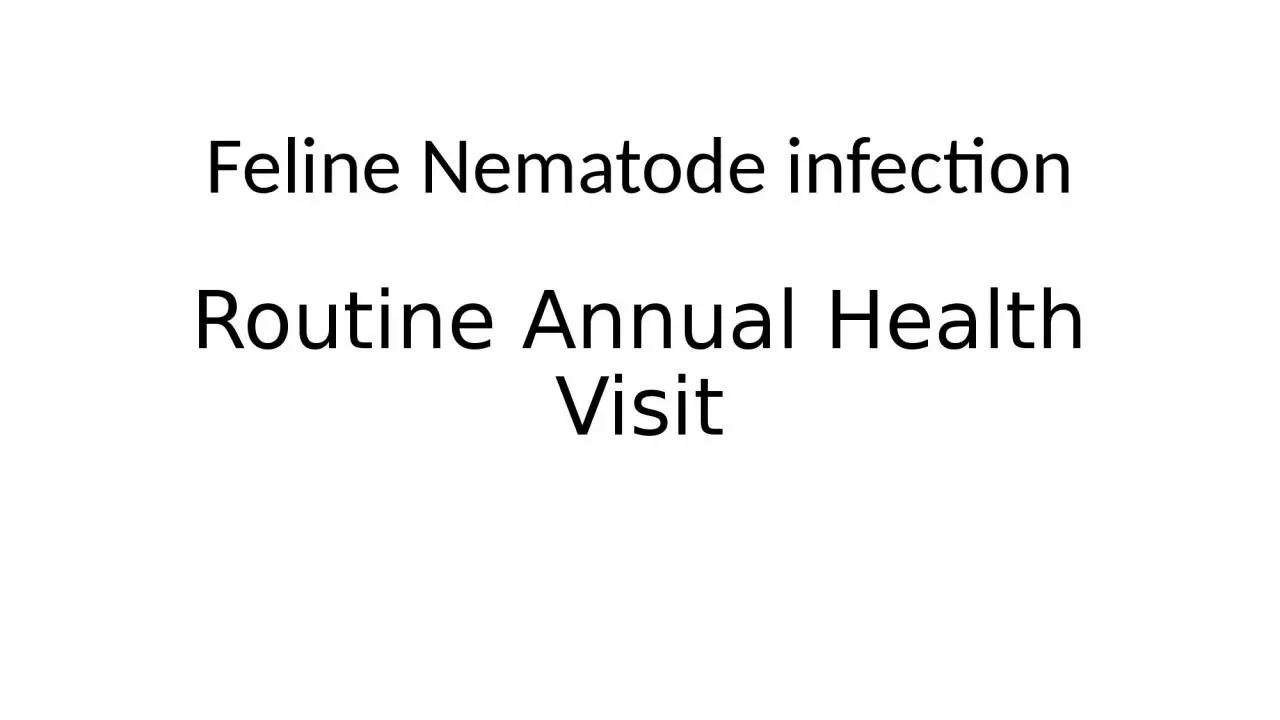

Feline Nematode infection History and Signalment Millie is a 4 year old FS Domestic Shorthair cat that lives indoors in an apartment building 21 st floor in center city Philadelphia She came in today for her annual checkup her third since she became a patient at this clinic ID: 1035815
Download Presentation The PPT/PDF document "Routine Annual Health Visit" is the property of its rightful owner. Permission is granted to download and print the materials on this web site for personal, non-commercial use only, and to display it on your personal computer provided you do not modify the materials and that you retain all copyright notices contained in the materials. By downloading content from our website, you accept the terms of this agreement.
1. Routine Annual Health VisitFeline Nematode infection
2. History and SignalmentMillie is a 4 year old, FS, Domestic Shorthair cat that lives indoors in an apartment building (21st floor) in center city Philadelphia. She came in today for her annual check-up (her third since she became a patient at this clinic). She is not displaying any clinical signs and her previous 2 annual exams both were unremarkable (no problems).She is not on any medications.She eats a mixture of commercial canned and dry cat food. No human food. No other pets in the apartment.
3. Physical ExamWeight 4.5 kgTemperature: 101FHeart: rate 180, no murmurs detectedRespiration: 24Body Condition: 6/9Skin and hair: excellent (Flea combing found no evidence of fleas)Ears: cleanEyes: no problemsMouth: Normal, no gingivitis or tarter.Fecal exam: Stool formed. Saturated salt centrifugational flotation showed several similar looking parasite eggs.
4. Problem ListParasite presentEgg measures: 65 X 75 μmand it has a rough (dimpled) surfaceDifferential Diagnosis (nematodes)Ancylostoma tubaeformeToxocara catiToxascaris leoninaCapillaria spp.Uncinaria stenocephalaPhysaloptera spp.
5. DiagnosisToxocara cati infection (rough surfaced ascarid egg from a cat)
6. Treatment PlanTreat Toxocara cati infection with FDA approved drug.Suggest to the owner that since we do not know how Millie became infected it would be best to put her on a monthly parasite prevention program (one that would also take care of fleas and heartworms).
7. Follow-upIf the owner chooses a monthly parasite prevention program, no follow-up is needed until Millie’s next scheduled check-up. (Make sure the owner leaves the clinic with the preventative and knows how to use it.)If the owner declines a monthly prevention program, request a fresh fecal sample be submitted 1 to 2 weeks after the last dose of anthelmintic in order to make sure the infection was completely cleared.
8. Test Your KnowledgeWhat are the FDA approved anthelmintics for treating Toxocara cati in the domestic cat? Which are currently commercially available in the US?How might Millie have been infected?
9. Toluene and Dichlorophene Not soldN-butyl Chloride Not soldPiperazine Not soldDiethylcarbamazine Citrate Not soldDichlorvos Not soldFebantel Not soldFebantel and Praziquantel Not soldMilbemycin Oxime AvailablePyrantel Pamoate and Praziquantel AvailableSelamectin AvailableMoxidectin and Imidacloprid AvailableEmodepside and Praziquantel AvailableWhat are the FDA approved anthelmintics for treating Toxocara cati in the domestic cat?Which are currently commercially available in the US?FDA web site checked and Google search for suppliers done on Dec 8, 2016
10. Possible routes of infection for Toxocara cati:Transmammary – Millie is 4 yrs old and previous check-ups were NPS. Toxocara cati adults don’t live 4 years. Ruled outParatenic host – Millie lives in an apartment on the 21st floor (indoor cat). Mice like apartments and can travel between apartments easier than the kitten next door can. PossiblePhoretic host – Ascarid eggs are known to be carried by flies and possibly other insects. Insects picking up eggs from not so clean litter pans in other apartments could carry the eggs to Millie (who being a cat most likely will stalk and eat them). PossibleIngestion of an infective egg - Millie lives in an apartment on the 21st floor (indoor cat). The owner could have brought an egg into the apartment on his shoes and Toxocara sp. eggs have been reportedly been found in commercial potting soil. PossibleReactivation of arrested larvae - Millie most likely had Toxocara cati as a kitten (most cats are exposed while nursing), so it is likely she has arrested Toxocara larvae in her tissues. Arrested larvae will sometimes unarrest in response to host signals other than those of pregnancy, although at lower rates. Possible
11. Case AuthorsUniversity of Pennsylvania School of Veterinary Medicine Thomas J. Nolan parasite@vet.upenn.edu Grace Anne Mengel